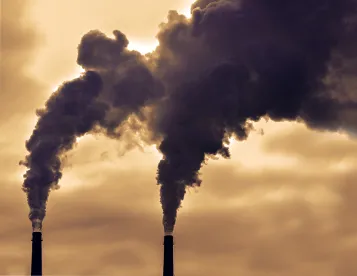On July 1, 2021, the Internal Revenue Service (IRS) released Revenue Ruling 2021-13 (the Revenue Ruling), addressing the application of section 45Q of the Internal Revenue Code of 1986, as amended (Section 45Q) to carbon dioxide captured with carbon capture equipment installed at a methanol plant with existing carbon dioxide separation equipment. Specifically, the Revenue Ruling provides guidance on three important topics: (i) whether dual use property is properly treated as carbon capture equipment for purposes of Section 45Q; (ii) the degree of ownership of carbon capture equipment necessary to claim the credit provided by Section 45Q; and (iii) the determination of the placed-in-service date for purposes of determining the eligibility for, and the appropriate rate of, credits under Section 45Q. The guidance generally can be regarded as favorable to taxpayers, and should prove useful to taxpayers seeking to structure investments into carbon capture equipment.
Background
Section 45Q, enacted in 2008 and expanded by the Bipartisan Budget Act of 2018, provides a tax credit based on the metric tons of carbon oxide captured by a taxpayer using carbon capture equipment placed in service at a qualified facility and disposed of, injected or utilized in a specified manner (the Section 45Q Credit). Section 45Q Credits generally are available at a higher rate for carbon oxide captured using carbon capture equipment placed in service on or after February 9, 2018. For carbon oxide captured using carbon capture equipment placed in service prior to February 9, 2018, the maximum credit generally is $20 per metric ton if such carbon oxide is disposed of in secure geological storage, and $10 per metric ton if such carbon oxide is injected for enhanced oil or gas recovery or utilized in a specified manner. In contrast, if the carbon capture equipment were placed in service on or after February 9, 2018, the maximum credit generally is $50 per metric ton if such carbon oxide is disposed of in secure geological storage, and $35 per metric ton if such carbon oxide is injected for enhanced oil or gas recovery or utilized in a specified manner.
Section 45Q does not define carbon capture equipment, however the final Treasury Regulations under Section 45Q, issued on January 6, 2021 (the Final Regulations), described in Bracewell’s alert available here, define carbon capture equipment as including all components of property that are used to capture or process carbon oxide until the carbon oxide is transported for disposal, injection, or utilization. Further, carbon capture equipment is equipment used for the purpose of (i) separating, purifying, drying, and/or capturing carbon oxide that would otherwise be released into the atmosphere from an industrial facility; (ii) removing carbon oxide from the atmosphere via direct air capture; or (iii) compressing or otherwise increasing the pressure of carbon oxide. Carbon capture equipment generally includes components of property necessary to compress, treat, process, liquefy, pump or perform some other physical action to capture qualified carbon oxide. All components that make up an independently functioning process train capable of capturing, processing, and preparing carbon oxide for transport will be treated as a single unit of carbon capture equipment (a single process train).
In the case of qualified carbon oxide captured using carbon capture equipment that is originally placed in service at a qualified facility on or after February 9, 2018, the Section 45Q Credit is attributable to the person that owns the carbon capture equipment and physically or contractually ensures the capture and disposal, injection, or utilization of such qualified carbon oxide. The Final Regulations provide that for each single process train of carbon capture equipment, only one taxpayer will be considered the person to whom the credit is attributable. That person will be the taxpayer who either physically ensures the capture and disposal, injection, or utilization of such qualified carbon oxide or contracts with others to capture and dispose, inject, or utilize such qualified carbon oxide.
The Revenue Ruling
The Revenue Ruling addresses the availability of the Section 45Q Credit for carbon oxide captured using carbon capture equipment added to a methanol plant by an investor in 2021. The plant produces methanol from petroleum coke using a multistep industrial process. The petroleum coke is gasified with high temperature steam to create raw syngas. The syngas then is purified in an acid gas removal (AGR) unit, which removes unwanted carbon dioxide, and the purified gas is converted into methanol.
The AGR unit at the methanol plant was placed in service on January 1, 2017. Since January 1, 2017, the carbon dioxide separated by this AGR unit has been released into the atmosphere and no taxpayer has claimed a Section 45Q Credit with respect to the facility. In 2021, an investor purchased and installed new components of carbon capture equipment necessary to create a single process train capable of capturing, processing, and preparing for transport the carbon dioxide that was being released into the atmosphere at the methanol facility. The investor did not acquire an ownership interest in the AGR unit or the methanol facility.
In the Revenue Ruling, the IRS concluded that the AGR unit is carbon capture equipment as defined in the Final Regulations, regardless of its other potential uses (such as the removal of other impurities), because at least one of the functions of the AGR unit is to separate carbon dioxide from a gas stream. The IRS further concluded that, although the investor did not own the AGR unit, the investor nevertheless could claim the Section 45Q Credits with respect to the carbon dioxide generated at the methanol facility, because it is not necessary to own all of the carbon capture equipment within a single process train to earn Section 45Q Credits. Rather, the person to whom the Section 45Q Credits are available must own at least one component of carbon capture equipment in a single process train of carbon capture equipment.
Finally, the IRS concluded that, for purposes of determining eligibility for Section 45Q Credits, as well as the appropriate rate, the relevant placed-in-service date is the original placed-in-service date of the single process train. Such unit of carbon capture equipment will be considered originally placed in service for purposes of Section 45Q on the date that any person first places it in a condition or state of readiness and availability for the specifically designed function of capturing, processing, and preparing carbon oxide for transport for disposal, injection, or utilization. In the case of the methanol facility, the relevant date occurred in 2021 when the new components of carbon capture equipment allowed the facility to capture, process, and prepare carbon oxide for transport for disposal, injection, or utilization, rather than release it into the atmosphere. Accordingly, the carbon dioxide captured at the methanol facility may be eligible for the higher rate of Section 45Q Credits available with respect to carbon capture equipment placed in service on or after February 9, 2018.
The Revenue Ruling also sought to reconcile the placed-in-service date for purposes of Section 45Q with the placed-in-service date for purposes of claiming depreciation deductions under Code sections 167 and 168. In this regard, the treatment of the single process train as a unit of property and its original placed-in-service date for purposes of Section 45Q has no effect on the determination of the original placed-in-service date of the AGR facility for depreciation purposes. Accordingly, the AGR unit's placed-in-service date for depreciation purposes remains January 1, 2017.
The Revenue Ruling provides clarity with respect to the availability of increased Section 45Q Credits for owners of carbon capture equipment recently installed, or yet to be installed, at gas processing facilities with gas separation equipment placed in service prior to February 9, 2018.





 />i
/>i

